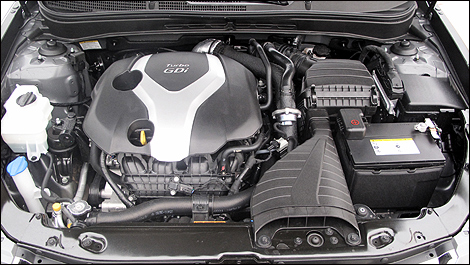TORRY PINES, CALIFORNIA — Hyundai raised eyebrows when it announced that this new-generation Sonata would not be available with a V6.
The three power options would be: 2.4-litre I4, 2.0-litre I4 with direct inject and turbocharging, and electric-gas hybrid.
 |
| The Sonata line starts at $22,000, so the turbo engine is definitely being billed and bundled as a premium piece. (Photo: Mike Goetz/Auto123.com) |
The turbo essentially replaces the 3.3-litre V6 as the “upgraded” engine option in the Sonata line.
After taking the 2.0 turbo Sonata for a switch-back mountain run, through the hills of Southwestern California, we are ready to say many things to that departing 3.3-litre V6, including… “Sayonara”… “Auf Wiedershen” … “Arrivederci” … and, “Don’t let the door hit you on your way out”.
High Tech Little Wonder
This engine shames that 3.3-litre V6, and is the measure, or betters, the V6 powerplants in many competing vehicles, such as Chevrolet Malibu,
Toyota Camry, and
Honda Accord. With better
fuel economy to boot — 9.3 L/100 km City, and 6.0 L/100 km. It also has an “Eco” mode to further increase fuel efficiency.
It is Hyundai's first engine with both direct injection and turbocharging. Net result, it is a powerhouse.
It produces 274 hp at 6,000 rpm and 269 lb-ft of torque from 1,750 to 4,500 rpm. It wasn’t too long ago that producing 100 horsepower per litre of engine displacement was considered racy and extremely high tech — now we have a totally mainstream sedan from Korea with a mill that produces over 137 hp per litre. And on regular fuel.
It has better numbers than the 2.0-litre EcoBoost in the upcoming Ford Focus ST (246 hp) and the 2.0-litre Ecotec in the Buick Regal (220 hp).
The turbocharger is of a twin-scroll design, which ultimately provides more efficient delivery of exhaust gases to the engine’s turbines, to pretty much eliminate turbo lag (the smaller vane gets up to the desired spinning rate faster than a larger vane, the larger vane allows for lots of boost).
 |
| This engine produces 274 hp at 6,000 rpm and 269 lb-ft of torque from 1,750 to 4,500 rpm. (Photo: Mike Goetz/Auto123.com) |

